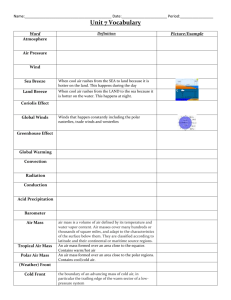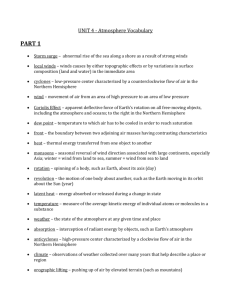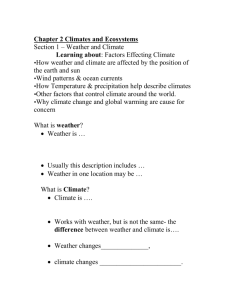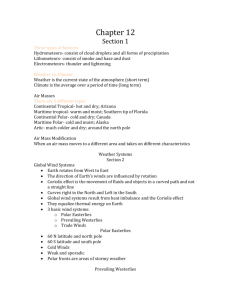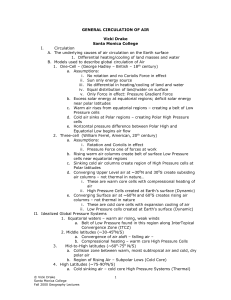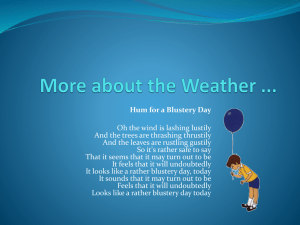8th Grade World Geography: Weather & Climate Notes
advertisement
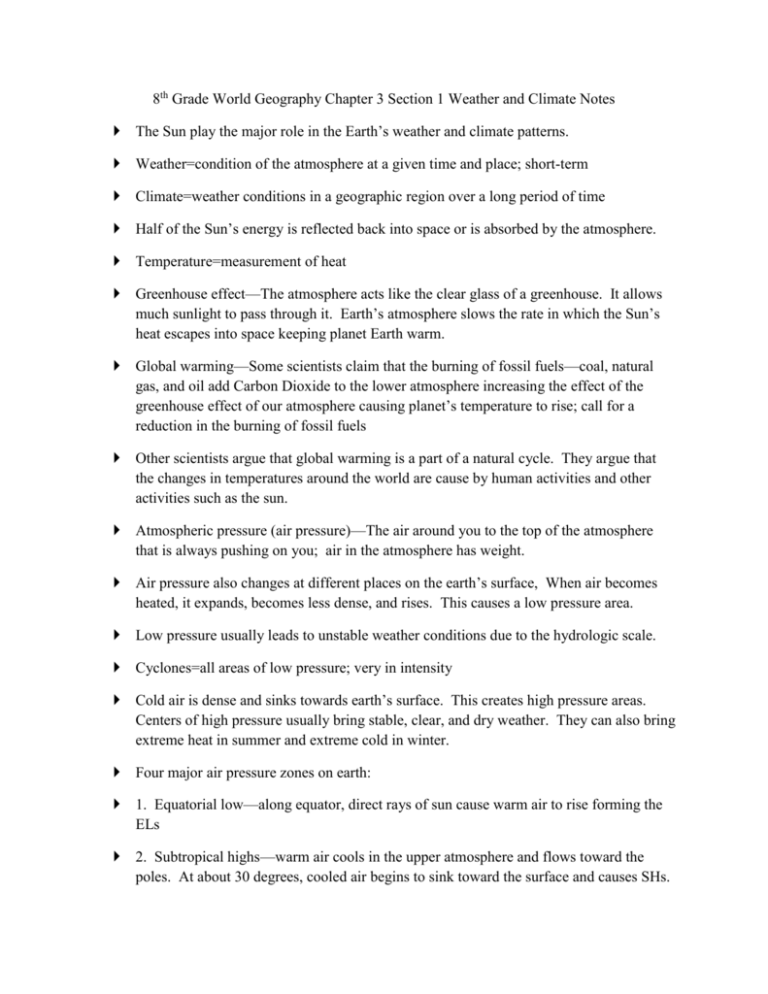
8th Grade World Geography Chapter 3 Section 1 Weather and Climate Notes The Sun play the major role in the Earth’s weather and climate patterns. Weather=condition of the atmosphere at a given time and place; short-term Climate=weather conditions in a geographic region over a long period of time Half of the Sun’s energy is reflected back into space or is absorbed by the atmosphere. Temperature=measurement of heat Greenhouse effect—The atmosphere acts like the clear glass of a greenhouse. It allows much sunlight to pass through it. Earth’s atmosphere slows the rate in which the Sun’s heat escapes into space keeping planet Earth warm. Global warming—Some scientists claim that the burning of fossil fuels—coal, natural gas, and oil add Carbon Dioxide to the lower atmosphere increasing the effect of the greenhouse effect of our atmosphere causing planet’s temperature to rise; call for a reduction in the burning of fossil fuels Other scientists argue that global warming is a part of a natural cycle. They argue that the changes in temperatures around the world are cause by human activities and other activities such as the sun. Atmospheric pressure (air pressure)—The air around you to the top of the atmosphere that is always pushing on you; air in the atmosphere has weight. Air pressure also changes at different places on the earth’s surface, When air becomes heated, it expands, becomes less dense, and rises. This causes a low pressure area. Low pressure usually leads to unstable weather conditions due to the hydrologic scale. Cyclones=all areas of low pressure; very in intensity Cold air is dense and sinks towards earth’s surface. This creates high pressure areas. Centers of high pressure usually bring stable, clear, and dry weather. They can also bring extreme heat in summer and extreme cold in winter. Four major air pressure zones on earth: 1. Equatorial low—along equator, direct rays of sun cause warm air to rise forming the ELs 2. Subtropical highs—warm air cools in the upper atmosphere and flows toward the poles. At about 30 degrees, cooled air begins to sink toward the surface and causes SHs. 3. Sub polar lows—At about 60 degrees latitude, the cold air forces warmer air flowing to the poles higher causing the SPLs 4. Polar highs—At poles, dense cold air sinks to the surface causing the PHs. Wind=horizontal flow of air; always flows from high to low pressure areas; move heat and cold across earth’s surface. Air pressure affects global wind patterns. Prevailing winds—Winds that blow from the same direction; trade winds and so-called doldrums In middle latitudes, the prevailing winds are called westerlies. Most of the lower 48 (contiguous) states of the US is located in the westerlies. Like its name suggests, westerlies carry most weather patterns and storms across US from west to east. In the high latitudes, the winds are more variable but come mainly from the east (cold polar easterlies). These strong winds blow from the Arctic and Antarctic into the middle latitudes. Only Alaska in US is north enough to be w/n the polar wind belt. A front occurs when two air masses of widely different temperatures or moisture meet. Precipitation often occurs along these fronts. Warm westerlies and cold polar winds meet between 40 and 60 degrees latitude; where these air masses meet is called the polar front The fastest of high-speed westerly winds is called the gulf stream. Wind speeds w/n this stream can reach up to 300 mph; usually two or three jet streams flowing in each hemisphere moving heat and steering weather patterns Oceans also effect climate because water heats and cools more slowly than land. Land areas near oceans do not have such great temperature ranges as areas in the interior of continents; Weather in Los Angeles versus Rochester, MN for example Great rivers of seawater=currents Earth’s winds and rotation as well as varying ocean temperatures create these ocean currents. Currents usually flow in circular paths: clockwise in the Northern Hemisphere and Counterclockwise in the Southern Hemisphere—water in toilet bowls too. Ocean currents move heat back and forth between the tropics and polar regions. This helps maintain earth’s temperature balance. Warm currents carry water from tropics to cooler middle latitudes. An example is the northern-flowing Gulf Stream, which runs along US East Coast. Cool currents return cool water from middle and high latitudes toward equator where it becomes warm again. The southern-flowing California Current off the West Coast is a cool current. Cold ocean currents cool nearby land areas. Warm ocean currents make nearby land warmer for example the British Isles.

